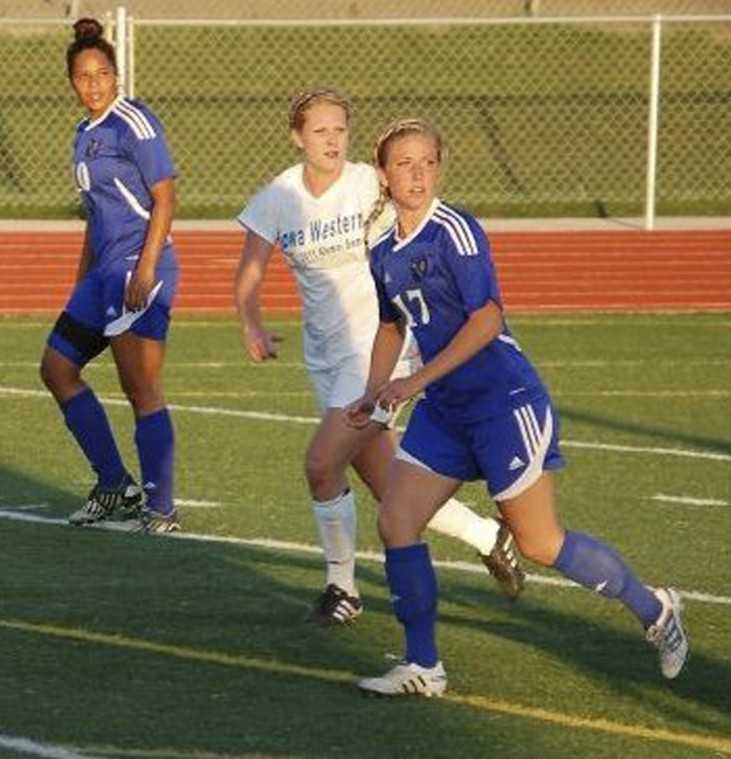When Robin Hansen finished her second season on the Iowa Western Community College soccer team, she thought her collegiate career was over.
However, Utah State head coach Heather Cairns had other plans.
The Sky View product was one of three players the Aggies recently inked in rounding out their 12-member recruiting class for the upcoming 2012 season.
“Robin has been somebody that we’ve been watching throughout her junior college career,” Cairns said. “I think she keeps getting better and better every time we see her, so when the opportunity to recruit her came up, we really jumped on that.”
The daughter of Karla and Bruce Axtell and Dell Loy and Lynnette Hansen played in every match for the Reivers in 2010 and 2011, and started all 18 matches as a sophomore. Hansen was one of the first players off the bench for most of the 2010 campaign, but did make some starts late in the season.
The Hyde Park resident helped anchor the Iowa Western midfield and finished her JUCO career with seven goals and five assists — six goals and three assists as a sophomore. Hansen was one of eight players from Cache Valley on the 2011 IWCC roster.
“It prepared me so much because I had no idea I’d ever be able to play Division I soccer, and I’m really glad I made a last-second decision to go to Iowa (Western),” Hansen said. “I made the decision a couple of weeks before graduating from high school, and it was really hard.”
Hansen earned her associate degree from Iowa Western early and transferred to USU, where she trained with the team during the 2012 spring semester. Hansen, who had three goals and three assists as a senior at Sky View, planned on remaining at USU regardless of whether or not she was offered a spot on the team.
Needless to say, Hansen impressed Cairns and the rest of the Aggie coaching staff during that time.
“She’s got a remarkable work rate and a remarkable attitude with just seizing the whole soccer experience and seizing the day ... and becoming the best player she can, so she’s got some intangibles off the field, as well, that really prepared her to step into the Division I level,” Cairns said.
Cairns, who led the Aggies to their first-ever NCAA Tournament bid last season, said Hansen’s willingness to get into better shape was arguably the biggest thing that stood out to her.
“The big thing was her fitness level and, with that, the ability to impact the game because she’s able to cover more ground,” Cairns said. “... She was just around the ball a lot more (as her JUCO career progressed).”
Hansen agreed with Cairns’ assessment and feels her work rate is the biggest strength she brings to the program.
“People have seen that I’m pretty much the slowest player, but I just have really good endurance,” said Hansen, who is majoring in business administration. “And even though I’m a little slower, I just work my butt off to get to that ball and make sure that I’m working extra hard because I don’t have that (speed) advantage.”
Hansen is one of three Cache Valley players to sign with or verbally commit to the Aggies — arguably the Western Athletic Conference’s premier program since joining the league in 2005 — over the past six or so months. Soon-to-be seniors Jessica Brooksby (Sky View) and Karlee Campbell (Mountain Crest) verbally committed to USU recently.
Former Mountain Crest star Jessica Hoskin is entering her junior year at USU and was the team’s starting left back as a sophomore.
“The programs in the valley just keep getting better, and I think Heather has noticed that,” Hansen said. “(The schools) are producing better players now, and it’s exciting to see (USU recruiting local players) happening.”
Along with Hansen, Cairns announced the signing of two other players last week in recent Bear River graduate Kaitlyn Wilcox and UNLV transfer Jackie Tillotson.
Wilcox, a forward, missed her senior season with the Bears as she was recovering from an ACL tear, but returned in time to capture two more 3A state track and field titles. Wilcox enjoyed a remarkable prep track career as she was a three-time state champion in the 200- and 400-meter dashes and a four-time state placer in the 100, 200 and 400.
The Tremonton native was an all-state soccer player as a junior as she scored a school-record 16 goals. Wilcox, whose older sister, Amanda, was a teammate of Hansen’s at Iowa Western, will also run track for USU.
Tillotson played two seasons for the Rebels and started eight matches in 2011, while playing in 16. Tillotson, a defender, assisted on one goal.
The Sandy native is the younger sister of Summer Tillotson, who was a standout player for USU from 2008-2011. Tillotson, a four-year starter, was arguably the WAC’s best outside back a season ago and was a two-time all-league selection.
The Aggies will return seven starters and 12 letterwinners from last year’s 15-5-2 squad. USU captured its third regular-season WAC title in four years in 2011.
———
View the original article here: http://news.hjnews.com/sports/article_9c14235a-bf4d-11e1-9151-001a4bcf887a.html












